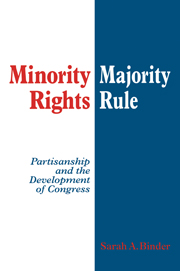Book contents
- Frontmatter
- Contents
- List of tables and figures
- Preface
- 1 The partisan basis of procedural choice
- 2 The evolving concepts of House and Senate minority rights
- 3 Procedural choice in the early Congress: The case of the “previous question”
- 4 Allocating minority rights in the House, 1789–1990
- 5 Institutionalizing party in the nineteenth-century House
- 6 Stacking the partisan deck in the twentieth-century House
- 7 Inherited rules and procedural choice in the Senate
- 8 Assessing the partisan theory
- Appendix 1 Summary of changes in minority rights
- Appendix 2 Measuring congressional workload
- Appendix 3 Measuring party behavior
- Bibliography
- Index
Appendix 3 - Measuring party behavior
Published online by Cambridge University Press: 10 December 2009
- Frontmatter
- Contents
- List of tables and figures
- Preface
- 1 The partisan basis of procedural choice
- 2 The evolving concepts of House and Senate minority rights
- 3 Procedural choice in the early Congress: The case of the “previous question”
- 4 Allocating minority rights in the House, 1789–1990
- 5 Institutionalizing party in the nineteenth-century House
- 6 Stacking the partisan deck in the twentieth-century House
- 7 Inherited rules and procedural choice in the Senate
- 8 Assessing the partisan theory
- Appendix 1 Summary of changes in minority rights
- Appendix 2 Measuring congressional workload
- Appendix 3 Measuring party behavior
- Bibliography
- Index
Summary
Any study of partisan behavior over time in Congress must come to terms with two vexing problems. First, there is no single way to measure partisanship, and second, there is no single way to identify political parties and their congressional rosters. Decisions made on both counts will affect assessments of party strength and conclusions drawn about the nature of partisan behavior over time. In this appendix, I explore these measurement concerns in greater detail and describe appropriate solutions.
Measuring party strength
In measuring party strength, two characteristics of partisanship have generally been of interest to Congressional scholars: the degree of intraparty cohesion (party unity) and the extent of interparty differences (party divisiveness) exhibited in congressional roll-call data. Consequently, studies of the impact of party on congressional voting have used a variety of different measures intended to capture either dimension or both in concert. Brady, Cooper, and Hurley (1979), for example, argue that the true influence of party on voting can be captured only by weighing both interparty conflict and intraparty unity. Thus, as a measure of party strength, they interact party voting levels with Rice party cohesion scores. To this mix of party measures, Clubb and Traugott (1977) add a party unlikeness score that measures the extent of differences between the two parties across roll-call votes. Whereas the party voting score for a Congress taps the frequency of party conflict on the floor, the party unlikeness measure captures the mean distance between the two major parties across all roll-calls.
- Type
- Chapter
- Information
- Minority Rights, Majority RulePartisanship and the Development of Congress, pp. 220 - 224Publisher: Cambridge University PressPrint publication year: 1997



